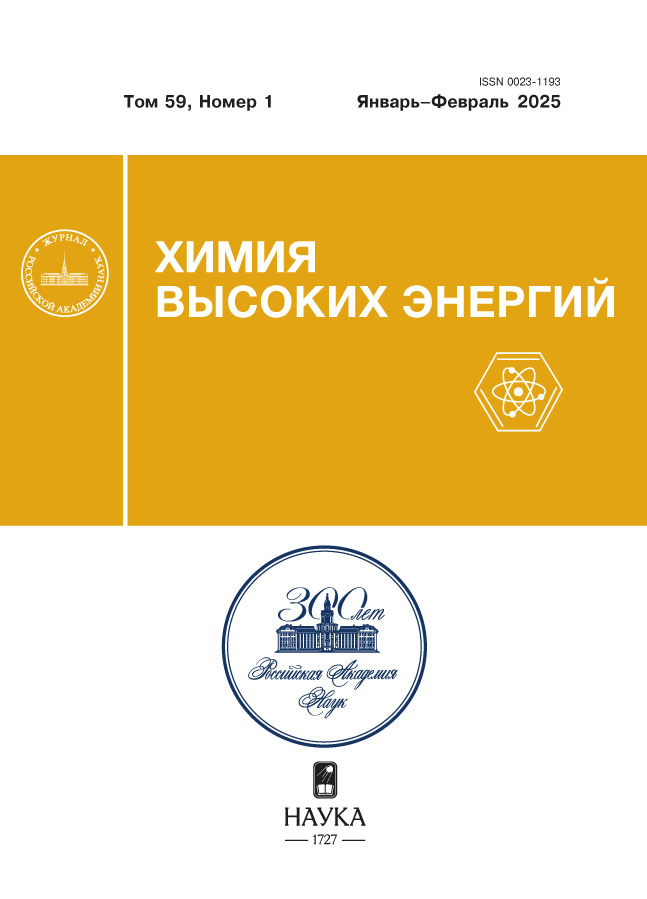Preparation and properties of propylene oxide fluorotelomers
- Authors: Kim I.P.1, Shestakov A.F.1, Shulga Y.M.1, Gak V.Y.1, Allayarov S.R.1
-
Affiliations:
- Federal Research Center of Problems of Chemical Physics and Medicinal Chemistry RAS
- Issue: Vol 59, No 1 (2025)
- Pages: 59-68
- Section: RADIATION CHEMISTRY
- URL: https://innoscience.ru/0023-1193/article/view/684670
- DOI: https://doi.org/10.31857/S0023119325010089
- EDN: https://elibrary.ru/SOYRJC
- ID: 684670
Cite item
Abstract
Telomeres are formed under the action of gamma rays from a 60Co source at room temperature in solutions of tetrafluoroethylene in propylene oxide with concentrations of 0.08–4.2 mol/L; telomer chain length depends on the monomer content in the solution. Monomer consumption during irradiation was controlled calorimetrically and gravimetrically; its complete conversion is observed at irradiation doses of 10–15 kGy. Molecular-mass characteristics of radiolysis products were determined by thermogravimetry. The telomeres with chain length less than 6 form true solutions. At the degree of monomer polymerization 6–15 colloidal solutions are formed, at more than 15 – dense gels. In the structure of propylene oxide fluorotelomer, the end functional epoxy group is retained. The morphology of the coating layers was investigated by atomic force microscopy.
Full Text
About the authors
I. P. Kim
Federal Research Center of Problems of Chemical Physics and Medicinal Chemistry RAS
Author for correspondence.
Email: ipkim@icp.ac.ru
Russian Federation, Chernogolovka
A. F. Shestakov
Federal Research Center of Problems of Chemical Physics and Medicinal Chemistry RAS
Email: ipkim@icp.ac.ru
Russian Federation, Chernogolovka
Yu. M. Shulga
Federal Research Center of Problems of Chemical Physics and Medicinal Chemistry RAS
Email: ipkim@icp.ac.ru
Russian Federation, Chernogolovka
V. Yu. Gak
Federal Research Center of Problems of Chemical Physics and Medicinal Chemistry RAS
Email: ipkim@icp.ac.ru
Russian Federation, Chernogolovka
S. R. Allayarov
Federal Research Center of Problems of Chemical Physics and Medicinal Chemistry RAS
Email: ipkim@icp.ac.ru
Russian Federation, Chernogolovka
References
- Иванчев С.С., Мякин С.В.// Успехи химии. 2010. Т. 72. С. 117.
- White W.R., Dueser M., Reed W.A., Onishi T. // IEEE Photonics Techn. Lett. 2000. V. 12. P. 347.
- Gravina R., Testa G., Bernini R. // Sensors. 2009. V. 9. P. 10423.
- McKeen L.W. / Fluorinated coatings and finishes handbook. PDL Series. N.Y.: Andrew Publ., 2005.
- Ameduri B., Boutevin B. Well-architectured fluoropolymers: Synthesis, properties and applications. Amsterdam: Elsevier, 2004.
- Potemkin I.I., Palyulin V.V. // Polym. Sci. Ser. A. 2009. V. 51. P. 163.
- Erukchimovich I., Theodorakis P.E., Paul W., Binder K. // J. Chem. Phys. 2011. V. 134. 054906.
- Soules A., Pozos C., Ameduri B., Joly-Duhamel C., Essahli M., Boutevin B. // J. Polym. Sci. A. 2008. V. 46. P. 3214.
- Schuman P.D. US Patent 5690863, November 25, 1997.
- Mah S., Choi J., Lee H., Choi S. // Fibers and Polymers. 2000. V. 1. P. 1.
- Chen Y., Zhang G., Zhang H. // J. Appl. Polym. Sci. 2001. V. 82. P. 269.
- Casagrande C., Fabre P., Raphael E., Veyssie M. // Europhys. Lett. 1989. V. 9. P. 251.
- Dendukuri D., Hatton T.A., Doyle P.S. // Langmuir 2007. V. 23. P. 4669.
- Elemants A.A.W., Lei S., De Feyer S. // Angew. Chem. Int. Ed. 2009. V. 48. P. 7298.
- Cadeddu A., Ciesielski A., El Malah T., Hecht S., Samori P. // Chem. Commun. 2011. V. 47. P. 10578.
- Ким И.П., Шестаков А.Ф. // Химия высоких энергий. 2009. Т. 44. C. 516.
- Ким И.П., Перепелицина Е.О., Шестаков А.Ф., Шульга Ю.М., Куница А.А. // Химия высоких энергий. 2011. Т. 45. № 6. C. 511.
- Perdew J.P., Burke K., Ernzerhof M. // Phys. Rev. Lett.1996. V. 77. P. 3865.
- Stevens W.J., Bash H., Krauss M. // J. Chem. Phys.1984. V. 12. P. 6026.
- Laikov D.N. // Chem. Phys. Lett. 1997. V. 281. P. 151.
- Шестаков А.Ф., Ким И.П. // Химия высоких энергий. 2009. Т. 44. C. 555.
- Ким И.П., Колесникова А.М. // Журнал физической химии. 2011. Т. 85. C. 1782.
- Ким И.П. // Химия высоких энергий. 2011. Т. 45. C. 399.
- Ким И.П., Бендерский В.А. // Химия высоких энергий. 2011. Т. 45. C. 406.
- Zhang Y., Lam Y.M. // J. Colloid and Interface Sci. 2005. V. 285. P. 80.
- Chou S.-H., Tsao H.-K., Sheng Y.-J. // J. Chem. Phys. 2011. V. 134. P. 034904.
- Liang C.Y., Krimm S. // J. Chem. Phys. 1956. V. 25. P. 563.
- Lappan U., Geißler U., Lunkwitz K. // Radiation Physics and Chemistry. 2000. V. 59. P. 317.
- Smith A.L. Applied Infrared Spectroscopy: Fundamentals, Techniques, and Analytical Problem-Solving. Chichester, UK: John Wiley & Sons, 1979.
Supplementary files


















